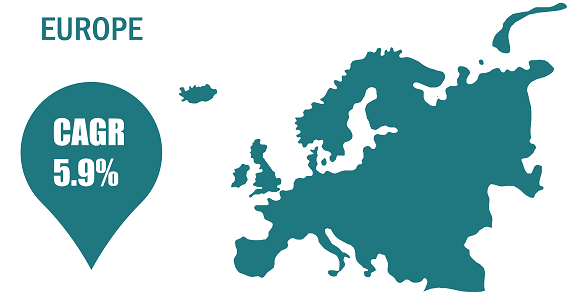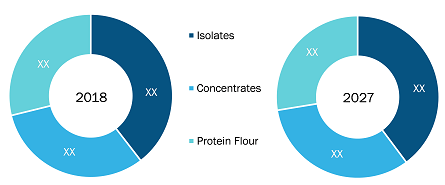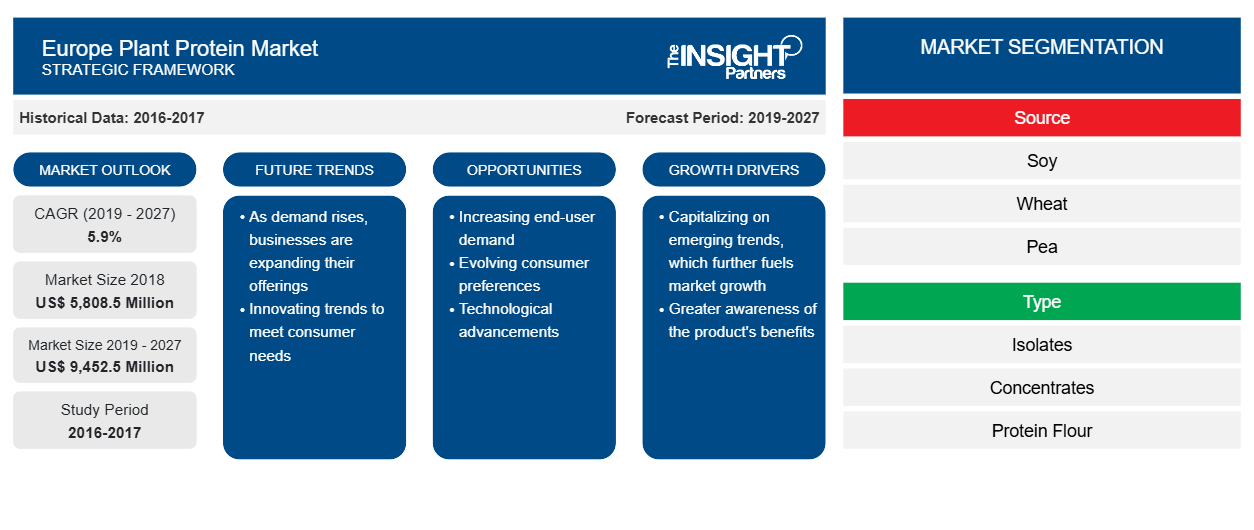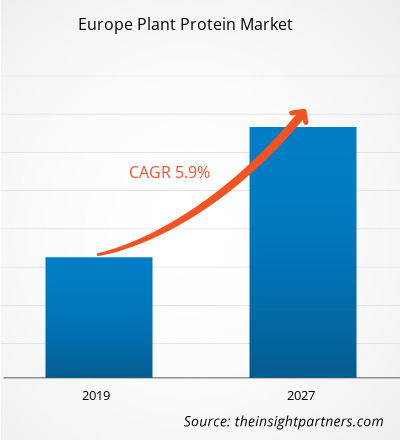The Europe plant protein market accounted for US$ 5,808.5 Mn in 2018 and is predicted to grow at a CAGR of 5.9% during the forecast period 2019 – 2027, to account for US$ 9,452.5 Mn by 2027.
Plant protein is a natural protein derived from plant sources such as soy, wheat, pea, and others. Plant protein provides building blocks for healthy muscles and tissues in the human body and is also beneficial for weight loss. Plant-based proteins tend to be lower in calories and fat as compared to animal proteins but higher in fiber and essential nutrients.
In 2018, rest of Europe dominated the Europe plant protein market, followed by Germany. The Rest of Europe include Spain, Austria, Poland, Portugal, and Turkey. These regions have registered a slow yet remarkable growth in the production and consumption of plant protein. The demand for plant protein in the Rest of Europe is forecasted to rise due to growing investment in research and development by manufacturers along with the growing number of applications such as food and beverages, cosmetic and personal care, and others. Also, robust growth in product offerings is impacting the market growth in the Rest of Europe.
While, in Germany, the high-protein trend is gaining a strong foothold. The most important driver of the plant protein market in Germany is changing trends in the wellness lifestyle of consumers. The consumption of nutritional supplements and its related products has shown significant growth over the past few years. Other drivers that lead the plant protein market are increasing preference for vegan and vegetarian food products over meat products.
Europe Plant Protein Market

- This FREE sample will include data analysis, ranging from market trends to estimates and forecasts.
Market Insights
Rising consumer awareness about protein-rich food
Proteins are building blocks to maintain the structure and functions of the human body. Proteins are made up of amino acids that are attached by peptide bonds in long chains. There are 20 different kinds of amino acids linked together that determines the role of protein in the human body. Proteins play a key role in transporting molecules throughout the body by helping in cell repair and protecting the body from viruses and bacteria. It also promotes proper growth and development in children, teenagers, and pregnant women. People consuming more protein tend to maintain bone mass better and have a much lower risk of osteoporosis and fractures. High protein intake has resulted in boosting metabolism that results in the burning of a high amount of calories. This further helps in proper weight management and weight loss. These benefits of protein are attracting consumers towards protein-rich food and beverages available in the market. This further creates a huge demand for plant proteins across Europe.
Source Insights
Based on source, the Europe plant protein market is bifurcated as soy, wheat, pea, and others. The soy segment led the Europe plant protein market by source. Soy protein isolate is a highly refined form of soy protein, with a protein content of minimum 90%. It is made from defatted soy flour from which most of the non-protein components, including fats and carbohydrates, are removed. Soy protein powder is made from defatted soybean flakes washed in either alcohol or water to remove the sugars and dietary fibers. They are then dehydrated and ground into powder. Soy protein powder is used to make infant soy formulae, as well as a variety of meat and dairy alternatives. Soy protein concentrates typically contain 70% soy protein and is basically defatted soy flour without the water-soluble carbohydrates. This form of protein is made by removing part of the carbohydrates from dehulled and defatted soybeans. Soy flour is made by grinding soybeans into a fine powder.
Type Insights
The Europe plat protein market is bifurcated based on type into isolates, concentrates, and protein flour. The concentrates segment held a significantly large share of the Europe plant protein market in 2018. Plant protein concentrates are produced by extracting protein from various sources such as soy, wheat, pea, quinoa, oats, beans, and nuts. Using heat and acid or enzymes. These typically supply 60–80% protein, with the remaining 20–40% composed of fat and carbs. The concentrated plant protein is the least processed type of protein powder. Plant protein in the concentrated form helps the muscles to recover quickly from heavy exercise as it is absorbed quickly by the body. Therefore, easy availability of plant protein concentrates coupled with lower prices compared to plant protein isolates are the key factors boosting the market.
Application Insights
The Europe plant protein market is bifurcated based on application into protein beverages, dairy alternatives, meat alternatives and meat extenders, protein bars, bakery, and others. The meat alternatives and meat extenders segment accounted for a major share in the Europe plant protein market. Beans and legumes are affordable sources of plant protein that serve as a meat substitute. Soy is also among the major source for producing meat alternatives. Pea protein isolates are mainly used by meat-alternative manufacturers such as Daiya, Gardein, Ben & Jerry's, Beyond Meat, Just Mayo, and Ripple Foods, among others. Therefore, surge in demand and production for meat alternatives results in higher demand for plant proteins. The demand for meat alternatives is increasing due to growing health concerns among consumers and growing preference for vegan food. Further, rising obesity levels due to the consumption of meat and meat products have led to an increasing consumer preference for meat substitutes.
Rest of Europe Plant Protein Market by Type

- This FREE sample will include data analysis, ranging from market trends to estimates and forecasts.
Customize This Report To Suit Your Requirement
You will get customization on any report - free of charge - including parts of this report, or country-level analysis, Excel Data pack, as well as avail great offers and discounts for start-ups & universities
Europe Plant Protein Market: Strategic Insights

-
Get Top Key Market Trends of this report.This FREE sample will include data analysis, ranging from market trends to estimates and forecasts.
New product development, market initiatives and merger and acquisition were observed as the most adopted strategies in Europe plant protein market. Few of the recent developments in the Europe plant protein market are listed below:
2020:
Beyond Meat entered into agreement with Roquette, which could lead to the growth of plant protein market.
2019:
DuPont Nutrition & Biosciences expanded its plant protein range under the brand DuPont Danisco which features pea and soy protein options and adds crunchy texture and higher protein content to snacks, cereals, nutritional bars and more.
2019:
Kerry Group is involved in manufacturing new allergen-free, vegan protein ingredient which has been manufactured for low-pH beverages.
EUROPE PLANT PROTEIN MARKET SEGMENTATION
By Source
- Soy,
- Wheat
- Pea
- Others
By Type
- Isolates
- Concentrates
- Protein Flour
By Application
- Protein Beverages
- Dairy Alternatives
- Meat Alternatives and Meat Extenders
- Protein Bars
- Bakery
- Others
By Country
- Germany
- France
- United Kingdom
- Italy
- Russia
- Rest of Europe
Company Profiles
- E. I. Du Pont De Nemours and Company
- Archer Daniels Midland Company
- Kerry Group
- Koninklijke DSM N.V.
- Axiom Foods, Inc
- Cargill, Incorporated
- Roquette Frères
- Ingredion Incorporated
- Glanbia plc
Europe Plant Protein Market Report Scope
| Report Attribute | Details |
|---|---|
| Market size in 2018 | US$ 5,808.5 Million |
| Market Size by 2027 | US$ 9,452.5 Million |
| CAGR (2019 - 2027) | 5.9% |
| Historical Data | 2016-2017 |
| Forecast period | 2019-2027 |
| Segments Covered |
By Source
|
| Regions and Countries Covered |
Europe
|
| Market leaders and key company profiles |
|
Europe Plant Protein Market Players Density: Understanding Its Impact on Business Dynamics
The Europe Plant Protein Market is growing rapidly, driven by increasing end-user demand due to factors such as evolving consumer preferences, technological advancements, and greater awareness of the product's benefits. As demand rises, businesses are expanding their offerings, innovating to meet consumer needs, and capitalizing on emerging trends, which further fuels market growth.

- Get the Europe Plant Protein Market top key players overview
- Historical Analysis (2 Years), Base Year, Forecast (7 Years) with CAGR
- PEST and SWOT Analysis
- Market Size Value / Volume - Regional, Country
- Industry and Competitive Landscape
- Excel Dataset
Recent Reports
Testimonials
Reason to Buy
- Informed Decision-Making
- Understanding Market Dynamics
- Competitive Analysis
- Identifying Emerging Markets
- Customer Insights
- Market Forecasts
- Risk Mitigation
- Boosting Operational Efficiency
- Strategic Planning
- Investment Justification
- Tracking Industry Innovations
- Aligning with Regulatory Trends






















 Get Free Sample For
Get Free Sample For